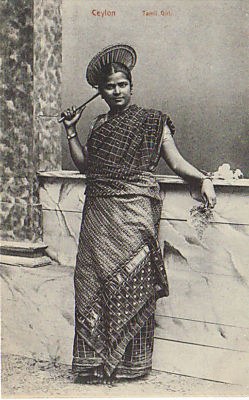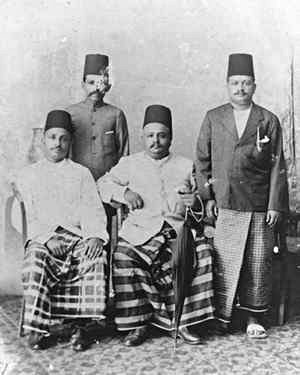
The Sri Lanka Broadcasting Corporation (SLBC) (Sinhala: ශ්රී ලංකා ගුවන් විදුලි සංස්ථාව, Shrī Lankā Guvan Viduli Sansthāva, Tamil: இலங்கை ஒலிபரப்புக் கூட்டுத்தாபனம், Ilangkai Oliparappuk Kūṭṭuttāpaṉam) came into existence on 5 January 1967 when Radio Ceylon became a public corporation. Dudley Senanayake who was the Prime Minister of Ceylon in 1967 ceremonially opened the newly established Ceylon Broadcasting Corporation along with Minister Ranasinghe Premadasa and the Director-General of the CBC, Neville Jayaweera. The first board of Directors of CBC consisted of Mr Neville Jayaweera (CCS), Mr A. L. M. Hashim, Mr Dharmasiri Kuruppu, Mr K.A.G. Perera and Mr Devar Surya Sena. After the first board meeting, it was decided unanimously to appoint the chairman, Mr Jayaweera, as the new Director-General.
Burgher people, also known simply as Burghers, are a small Eurasian ethnic group in Sri Lanka descended from Portuguese, Dutch, British and other Europeans who settled in Ceylon. The Portuguese and Dutch had held some of the maritime provinces of the island for centuries before the advent of the British Empire. With the establishment of Ceylon as a crown colony at the end of the 18th century, most of those who retained close ties with the Netherlands departed. However, a significant community of Burghers remained and largely adopted the English language. During British rule, they occupied a highly important place in Sri Lankan social and economic life.

Hinduism is one of Sri Lanka's oldest religions, with temples dating back over 2,000 years. As of 2011, Hindus made up 12.6% of the Sri Lankan population. They are almost exclusively Tamils, except for small immigrant communities from India and Pakistan.
The caste systems in Sri Lanka are social stratification systems found among the ethnic groups of the island since ancient times. The models are similar to those found in Continental India, but are less extensive and important for various reasons. Modern times Sri Lanka is often considered to be a casteless society in south asia.

Salagama is a Sinhalese caste found mostly in the southern coastal areas of Sri Lanka. The community was traditionally associated with the cultivation and management of cinnamon and were formerly also involved as weavers and soldiers.
Sri Lanka is a country in the northern Indian Ocean which has been known under various names over time.

Sri Lankan Tamils, also known as Ceylon Tamils or Eelam Tamils, are Tamils native to the South Asian island state of Sri Lanka. Today, they constitute a majority in the Northern Province, form the plurality in the Eastern Province and are in the minority throughout the rest of the country. 70% of Sri Lankan Tamils in Sri Lanka live in the Northern and Eastern provinces.
Bharatha People also known as Bharatakula and Paravar, is an ethnicity in the island of Sri Lanka. Earlier considered a caste of the Sri Lankan Tamils, they got classified as separate ethnic group in the 2001 census. They are descendant of Tamil speaking Paravar of Southern India who migrated to Sri Lanka under Portuguese rule. They live mainly on the western coast of Sri Lanka and mainly found in the cities of Mannar, Negombo and Colombo.
Koviyar is a Tamil caste found in Sri Lanka. They are traditional agriculturalists and temple workers but also included merchants, landowners and temple patrons. Kattavarayan as caste deity is observed by the Koviar. They are reputed as a ritually dominant caste and the "cousin" caste of the more numerical dominant caste, Sri Lankan Vellalar.

Karava is a Sinhalese speaking ethnic group of Sri Lanka, whose ancestors migrated throughout history from the Coromandel coast, claiming lineage to the Kaurava royalty of the old Kingdom of Kuru in Northern India. The Tamil equivalent is Karaiyar. Both groups are also known as the Kurukula.

Sri Lankan Moors are an ethnic minority group in Sri Lanka, comprising 9.3% of the country's total population. Most of them are native speakers of the Tamil language. The majority of Moors who aren’t native to the North and East also speak Sinhalese as a second language. They are predominantly followers of Islam. The Sri Lankan Muslim community is mostly divided between Sri Lankan Moors, Indian Moors, Sri Lankan Malays and Sri Lankan Bohras. These groups are differentiated by lineage, language, history, culture and traditions.

Sri Lankan place name etymology is characterized by the linguistic and ethnic diversity of the island of Sri Lanka through the ages and the position of the country in the centre of ancient and medieval sea trade routes. While typical Sri Lankan placenames of Sinhalese origin vastly dominate, toponyms which stem from Tamil, Dutch, English, Portuguese and Arabic also exist. In the past, the many composite or hybrid place names and the juxtaposition of Sinhala and Tamil placenames reflected the coexistence of people of both language groups. Today, however, toponyms and their etymologies are a source of heated political debate in the country as part of the political struggles between the majority Sinhalese and minority Sri Lankan Tamils.

British Ceylon, officially British Settlements and Territories in the Island of Ceylon with its Dependencies from 1802 to 1833, then the Island of Ceylon and its Territories and Dependencies from 1833 to 1931 and finally the Island of Ceylon and its Dependencies from 1931 to 1948, was the British Crown colony of present-day Sri Lanka between 1796 and 4 February 1948. Initially, the area it covered did not include the Kingdom of Kandy, which was a protectorate, but from 1817 to 1948 the British possessions included the whole island of Ceylon, now the nation of Sri Lanka.
The Scout and Guide movement in Sri Lanka is served by the Sri Lanka Scout Association and the Sri Lanka Girl Guides Association.
Social class in Sri Lanka is often described as casteless, though caste is still found on the island in both a symbolic and a practical sense. Caste is also used in an analogous sense to refer to the new social class divisions that have appeared in recent decades. The combination of ethnic nationalist movements that saw caste as an island-wide dividing tool, strong emphasis on providing access to education and healthcare regardless of background, and historic lack of discrimination among the colonial civil service played a factor in eradicating the caste system in most sectors of the island's society. Although the Buddhist culture actively fought against all forms of class discrimination, many Buddhist organizations used caste as a method to extract surplus from temple property.
Indians in Sri Lanka refer to Indians or people of Indian ancestry living in Sri Lanka, such as the Indian Tamils of Sri Lanka.
The Dutch Burghers are an ethnic group in Sri Lanka, of mixed Dutch, Portuguese Burgher and Sri Lankan descent. However, they are a different community when compared with Portuguese Burghers. Originally an entirely Protestant community, many Burghers today remain Christian but belong to a variety of denominations. The Dutch Burghers of Sri Lanka speak English and the local languages Sinhala and Tamil.

Tamil settlement of Sri Lanka refers to the settlement of Tamils, or other Dravidian peoples, from Southern India to Sri Lanka. Due to Sri Lanka's close proximity to Southern India, Dravidian influence on Sri Lanka has been very active since the early Iron Age or megalithic period.

This is a bibliography of works on Sri Lanka.

Simon Casie Chetty was a Ceylonese civil servant, author and member of the Legislative Council of Ceylon.











